The Evolutionary Journey of Sports Cards: From Tobacco Marketing to Cultural Icons
Sports cards, originating as simple marketing inserts in tobacco products in the late 19th century, have evolved into a dynamic aspect of sports culture. This article explores the transformation of these cards from mere advertising tools to treasured collectibles. We trace their journey from the iconic T206 set, through the introduction of player statistics in the early 20th century, to the bubble gum era which solidified their appeal among the youth. Moving through the technological advancements of the late 20th century to the digital innovations of the 21st, we examine how sports cards reflect the evolving intersection of sports, marketing, and technology. Join us in exploring the rich history and cultural significance of sports cards. Preserve your prized sports cards with our top-tier sports card carrying cases and sports card backpacks. Keep your collection safe and secure while staying organized and protect your investment!
The Introduction of Sports Cards in the Late 1800s:
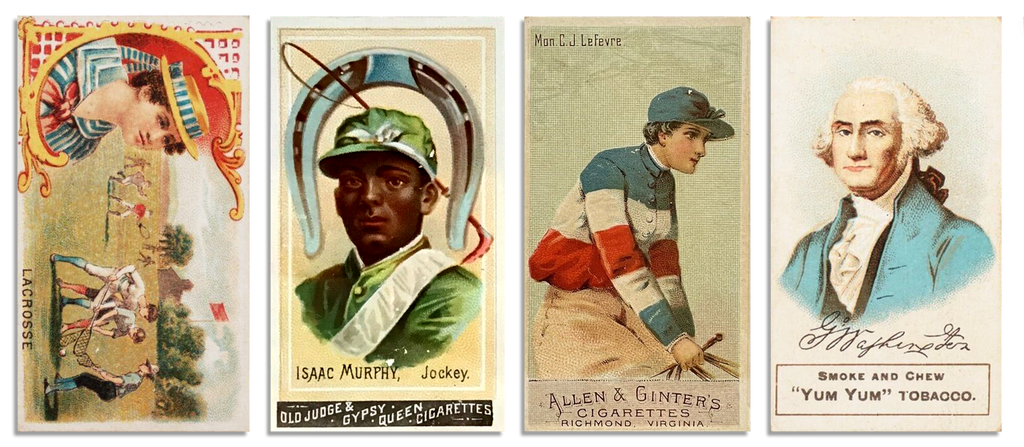
Initially, sports cards were not created with the intent of becoming collectibles. They were primarily marketing tools used by tobacco companies. The late 1800s was a period marked by a significant rise in the popularity of both smoking and professional sports. Tobacco companies saw an opportunity to capitalize on these trends by including cards in cigarette packs.
These cards, often referred to as "trade cards," served a dual purpose. Firstly, they provided structural support to the cigarette packaging, helping to prevent the cigarettes from being crushed. Secondly, and more importantly from a marketing perspective, they were used to advertise the tobacco company's brand. The inclusion of popular figures like actors, actresses, and athletes on these cards was a strategic move. It was a way to appeal to a broad audience and create a connection between the consumer and the brand.
Among the subjects featured on these early cards, athletes quickly became some of the most popular. This was due in part to the growing interest in professional sports during this era. Baseball, in particular, was rising in prominence in the United States, and the depiction of baseball players on these cards resonated with the public. This popularity laid the groundwork for the eventual emergence of sports cards as a distinct category.
These early sports cards were quite different from what we see today. They were often more artistic in nature, featuring hand-drawn images and elaborate designs. The back of the cards typically contained advertisements for the tobacco product or other information about the company.
The 1909-1911 T206 set, produced by the American Tobacco Company, is one of the most iconic and valuable in the history of sports cards. Let's delve into some of its key aspects:
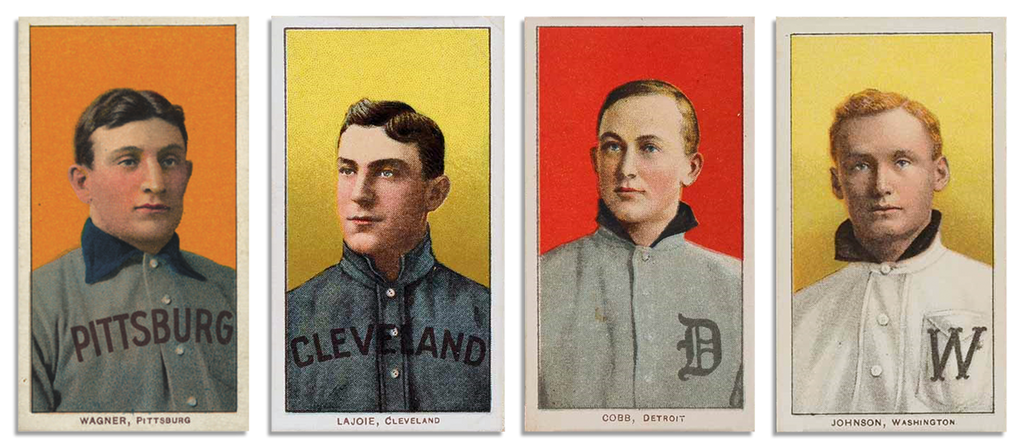
- Production and Distribution: The T206 set was produced over a span of three years, from 1909 to 1911. These cards were distributed in cigarette and tobacco packs as a promotional item. The set's long production run and the variety of brands under the American Tobacco Company's umbrella contributed to the large number of cards and variations within the set.
- Design and Imagery: The cards are renowned for their artistic quality. They feature vivid, colorful lithographs of players, and are often praised for their detailed and lifelike depictions. Each card has the player's name and team at the bottom, with a variety of back designs featuring advertisements for different tobacco brands.
- Scope and Rarity: With over 500 cards, the T206 set is one of the most extensive pre-war sports card sets. It includes players from both major and minor leagues, and due to its wide distribution, there are numerous variations and rarities within the set. This diversity makes it a particularly intriguing set for collectors.
- Famous Players: The set includes cards of some legendary figures in baseball history, like Ty Cobb, Honus Wagner, Cy Young, and Christy Mathewson. The presenceof such prominent players greatly enhances the set's appeal and value.
- The Honus Wagner Card: One of the most famous cards in the set, and indeed in the entire sports card collecting world, is the Honus Wagner card. Wagner, a Pittsburgh Pirates shortstop, was one of the era's greatest players. His card is extraordinarily rare, partly because Wagner objected to the use of his image, purportedly because he did not want to promote tobacco products to children. This led to a limited production of his card, making it one of the rarest and most valuable sports cards in existence. A Honus Wagner T206 card in good condition can fetch millions of dollars at auction.
- Value and Collectability: The T206 set is highly valued by collectors both for its historical significance and its rarity. The age, condition, and rarity of individual cards can lead to substantial prices. It's not just the famous players whose cards are valuable; even lesser-known players can command high prices due to the set's overall rarity and significance in the history of sports cards.
The T206 set is a cornerstone of sports card collecting, representing a unique intersection of art, history, and sport. Its enduring legacy is a testament to the cultural impact of baseball in the early 20th century and the evolving nature of collectibles over time.
The Evolution of Sports Cards in the 1920s – 1930s:

The evolution of sports cards in the 1920s and 1930s marked a significant shift in their purpose and appeal, transforming them from simple promotional items into a more engaging and informative collectible. Here's an expansion on the developments during this period:
- Inclusion of Statistics and Biographical Information: One of the most pivotal developments was the addition of player statistics and biographical information on the cards. This innovation was more than just a design change; it fundamentally altered how collectors interacted with the cards. By including stats like batting averages, home runs, and pitching records, along with personal information like birthplace, height, and weight, the cards became a source of information and learning.
- Educational Aspect and Increased Engagement: The inclusion of this data added an educational component to collecting. Fans could learn about players' careers and compare statistics, deepening their understanding of the sport. This also increased engagement with the cards, as collectors could now use them for more than just visual appreciation; they could study and analyze the information, fostering a deeper connection with the players and the game.
- Growing Popularity of Professional Sports: This period also saw a surge in the popularity of professional sports, particularly baseball, which was known as "America's Pastime." The growing media coverage of sports and the rise of iconic athletes helped fuel interest in sports cards.
- Impact on the Hobby's Dynamics: The addition of statistics and biographical information turned sports card collecting into a more dynamic hobby. Collectors began to seek specific cards based on a player's performance and career achievements. This also introduced the concept of card value being tied not just to rarity and condition, but also to a player's success and popularity.
- Design and Aesthetic Changes: Alongside these informational additions, there were also changes in the design and aesthetics of the cards. The cards from this era often featured more sophisticated and varied designs compared to the earlier trade cards, reflecting advances in printing technology and design trends.
- Expansion Beyond Baseball: While baseball cards were still predominant, this era also saw the expansion of sports cards to include other sports like football, boxing, and basketball, reflecting the growing popularity of these sports in American culture.
The 1920s and 1930s were a transformative period for sports cards, marked by a shift towards a younger audience, the inclusion of statistical and biographical information, and a broadening in the types of sports represented. These changes made sports cards more informative, engaging, and reflective of the growing cultural significance of professional sports in America.
The Introduction of Bubble Gum in Sports Cards in the 1950s:

The introduction of bubble gum into the packaging of sports cards in the early 1950s by Bowman Gum Company represented a significant milestone in the history of sports cards, both in terms of marketing and cultural impact. Here's an expanded look at this development:
- Bowman Gum Company's Initiative: In the early 1950s, Bowman Gum Company, a key player in the gum and card industry, started including a piece of bubble gum in each pack of their baseball cards. This was a strategic marketing move aimed at attracting a younger audience and increasing the appeal of collecting sports cards.
- Immediate Popularity: The combination of sports cards and gum was an instant hit among consumers, particularly children and teenagers. The idea of getting a sweet treat along with cards featuring their favorite athletes was appealing and added a new dimension to the experience of collecting sports cards.
- Impact on Sales and Collecting: The inclusion of gum led to a significant increase in sales of sports cards. It created an incentive for children to buy more packs in pursuit of completing their card collections, while also enjoying the gum. This approach fundamentally changed the way sports cards were marketed and consumed.
- Expansion Beyond Baseball: Following the success in baseball cards, the concept was expanded to include other sports as well. Soon, collectors could find football, basketball, and hockey cards packaged with bubble gum. This diversification helped popularize these sports and their players among a broader audience, contributing to the growth of sports card collecting as a multi-sport hobby.
- Rivalry and Competition: Bowman's success caught the attention of other companies, leading to increased competition in the sports card industry. Topps, another gum company, emerged as a major competitor. This rivalry led to innovations in card design, quality, and content, as each company sought to outdo the other in attracting collectors.
- Cultural Impact: The inclusion of gum with sports cards played a significant role in embedding the hobby in American pop culture, especially among children. It became a staple of youth culture in the 1950s and 1960s, with trading and collecting sports cards becoming a common pastime.
- Collectible Value and Nostalgia: Many of the cards from this era have become highly collectible due to their historical significance, nostalgia, and the stars they featured. The condition of these cards, especially those free of gum stains (a common issue given their packaging with gum), significantly influences their value today.
- Evolution of Card Content: This period also saw further evolution in the content of cards. Companies began to experiment with different types of imagery, statistics, and player information, continually enhancing the appeal and informational value of sports cards.
The introduction of bubble gum with sports cards in the early 1950s by Bowman Gum Company was a game-changer. It not only boosted the popularity and sales of sports cards but also helped in broadening the scope of the hobby to include various sports, thereby cementing sports card collecting as a significant aspect of American culture, particularly among the youth.
Innovation and Sophistication of Sports Cards in the 1960s – 1970s:

The 1960s and 1970s were a period of significant evolution and sophistication in the world of sports cards. This era saw various changes and innovations that helped shape the hobby into a more mature and diverse market. Here are some notable developments during these decades:
- Technological Advancements in Printing and Design: Improvements in printing technology during this era allowed for better quality and more visually appealing sports cards. The cards featured sharper images, brighter colors, and more detailed designs compared to earlier versions. This enhanced the aesthetic appeal of the cards and made them more attractive to collectors.
- Increased Focus on Photography: There was a shift towards using actual photographs of players rather than illustrations. This change gave the cards a more realistic and personal feel, allowing fans to connect more directly with their favorite athletes. Action shots and in-game photographs started becoming common, adding dynamism to the cards.
- Expansion of Card Sets and Series: Card manufacturers began producing larger sets with more players included. This allowed for a wider representation of athletes, including not just stars but also lesser-known players, which appealed to a broader range of collectors and fans.
- Diversification of Sports: While baseball cards continued to be the mainstay, there was a notable increase in the production of cards for other sports like football, basketball, hockey, and even non-traditional sports. This diversification mirrored the growing popularity of these sports in American culture.
- Introduction of Special Editions and Subsets: Card companies started to introduce special editions and subsets within their main series. These could include rookie cards, all-star selections, and highlight cards commemorating special events or achievements. These subsets added an extra layer of collectability and interest.
- Rookie Cards Becoming a Focal Point: The concept of the rookie card (the first card of a player) began to gain more importance. Collectors started to place a higher value on these cards, speculating that they would increase in value as the player's career progressed.
- Emergence of Card Collecting as a More Serious Hobby: The 1960s and 1970s saw the hobby of card collecting start to be taken more seriously. It wasn't just a child's pastime anymore; adults were also actively participating. This shift was partly due to the growing nostalgia for cards and the realization that cards could be valuable collectibles.
- Rise of the Secondary Market and Trade Shows: There was a growth in the secondary market for sports cards, with more trade shows and conventions being organized. These events provided platforms for collectors to buy, sell, and trade cards, and helped to cultivate a community around the hobby.
Surge in Popularity of Sports Cards in the 1980s:
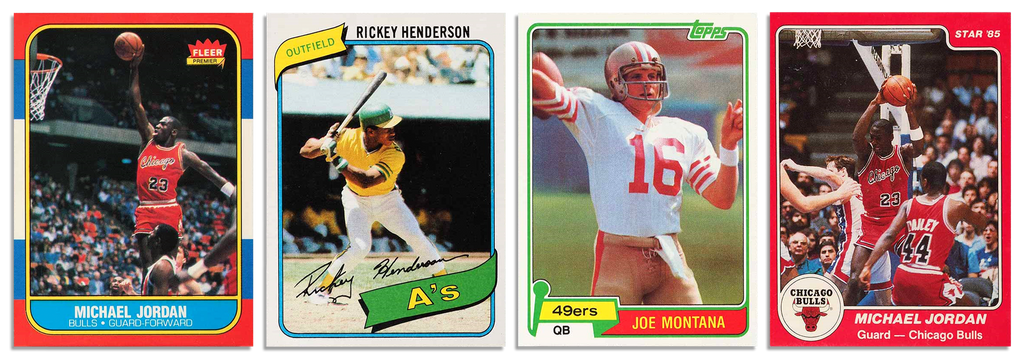
- Emergence of Card Shops and Conventions: The 1980s saw a boom in the number of card shops and the prevalence of sports card conventions. Card shops became common in many communities, serving as hubs for collectors to buy, sell, and trade cards. Conventions and trade shows, often on a larger scale, brought collectors from diverse locations together. These events provided opportunities for networking, learning about new trends, and engaging in the wider community of the hobby.
- Innovative Card Designs and Technologies: The 1980s was a decade of innovation in card design and production. Companies began experimenting with new technologies and materials to make cards more attractive and unique. This included the introduction of holographic cards, which had a shimmering, three-dimensional appearance, and foil-stamped cards, which featured metallic accents for a more premium look.
- Rise of New Companies and Brands: This decade witnessed the entry of new companies into the sports card market, increasing competition and variety. Brands like Upper Deck, which debuted in 1989, brought new ideas and quality standards to the industry, further invigorating the market.
- Emergence of Sports Cards as Investment Pieces: The 1980s saw a shift in the perception of sports cards from simple collectibles to potential investment pieces. The increasing value of rare and vintage cards, along with the popularity of rookie cards of emerging stars, led collectors to view sports cards as a form of financial investment.
- Global Expansion and Increased Licensing: The sports card industry began to expand globally during this period, with companies securing licensing deals with sports leagues and associations to reach international markets.
The 1980s were a transformative decade for sports cards, characterized by a surge in popularity, community building through shops and conventions, and significant innovations in card design and technology. These developments not only enhanced the appeal of card collecting but also laid the groundwork for the modern sports card industry.
Technological Advancements and Premium Sports Cards in the 1990’s:
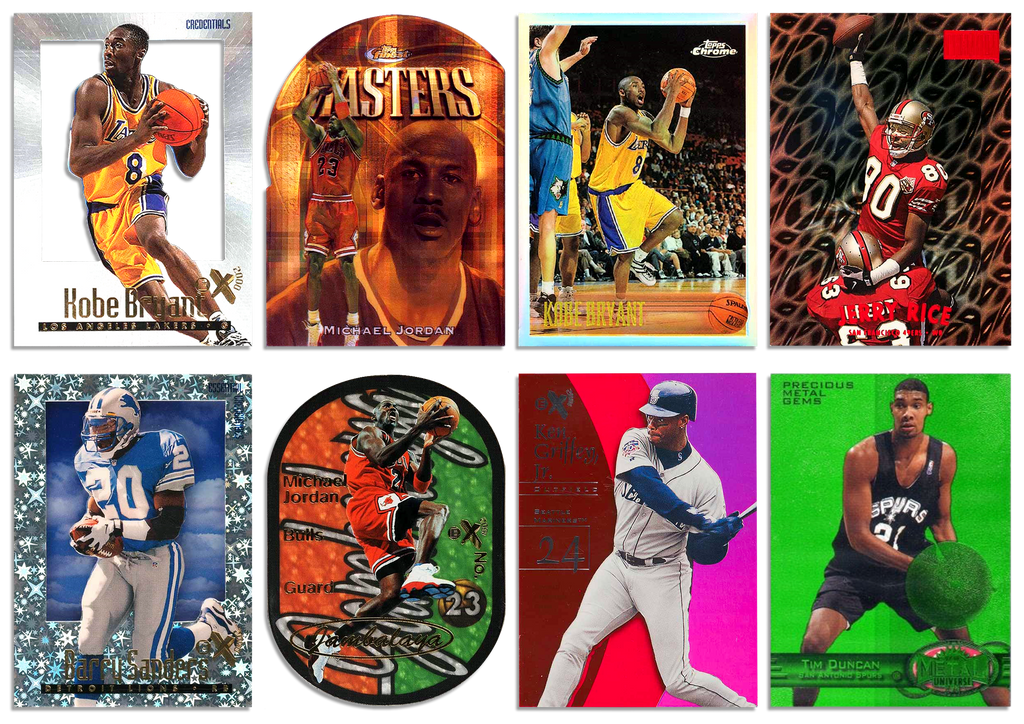
The 1990s marked a pivotal era in the history of sports cards, characterized by unprecedented growth, technological advancements, and several key trends that profoundly influenced the industry and collecting community. Here’s an expanded look at these developments:
- Widespread Overproduction and Market Saturation: A defining feature of the 1990s sports card industry was the rampant overproduction of cards. Driven by the previous decade's boom, card manufacturers produced cards on a massive scale, leading to a glut in the market. This oversupply ultimately diminished the rarity and value of many cards from this era.
- Technological Advancements and Premium Products: The 1990s witnessed significant advancements in card manufacturing technology. This led to the production of higher quality, more sophisticated cards featuring advanced printing techniques, better quality paper, and unique designs. Premium and limited-edition card series, with higher price points and superior quality, became popular among collectors.
- The Rise of Insert Cards and Chase Cards: A major trend of the 90s was the introduction of insert cards, or "chase cards," which were randomly included in card packs. These included autographed cards, memorabilia cards (containing pieces of player jerseys, bats, etc.), serial numbered cards, and holographic or foil cards. Such inserts added excitement and a treasure hunt aspect to collecting, as these cards were often rare and highly valued.
- Expansion of Sports Represented: The 1990s saw the expansion of the sports card market beyond the traditional baseball, basketball, and football cards. This era introduced a wider variety of sports, including hockey, soccer, and even non-traditional sports like NASCAR and wrestling, catering to a more diverse group of fans and collectors.
- Dominance and Diversification of Brands: The market saw the dominance of major brands like Topps, Upper Deck, and Fleer, alongside new entrants that further diversified the market. This competition led to constant innovation in card design and marketing strategies to capture the interest of collectors.
- Shift Towards Collecting as an Investment: Like the 1980s, the 1990s continued the trend of viewing sports cards as potential investments. However, due to overproduction, many cards from this era later struggled to retain their value. This period also saw heightened interest in grading services, which assessed and certified the condition of cards, adding to their perceived investment value.
- Increased Licensing and Player Endorsements: The 1990s experienced an increase in licensing agreements between card companies and sports leagues, as well as direct endorsements from athletes. This led to better representation of players and teams on cards and more official and authentic products.
- Influence of the Internet and Beginning of Online Trading: As the internet became more accessible in the late 90s, it began to influence the sports card industry. Online forums and marketplaces emerged, allowing collectors to connect, trade, and sell cards more easily on a global scale.
- Decline and Market Correction: Towards the end of the 1990s, the sports card market experienced a significant correction. The oversupply of cards, along with waning interest, led to a decline in both the value of cards and the number of active collectors.
The 1990s were a dynamic and transformative decade for sports cards, marked by technological advancements, market saturation, and a shift in collector behavior. While the era introduced exciting innovations and expanded the sports card market, it also faced challenges that led to significant changes in the industry.
Innovation and Expansion of Sports Cards in the 2000s and 2010s:
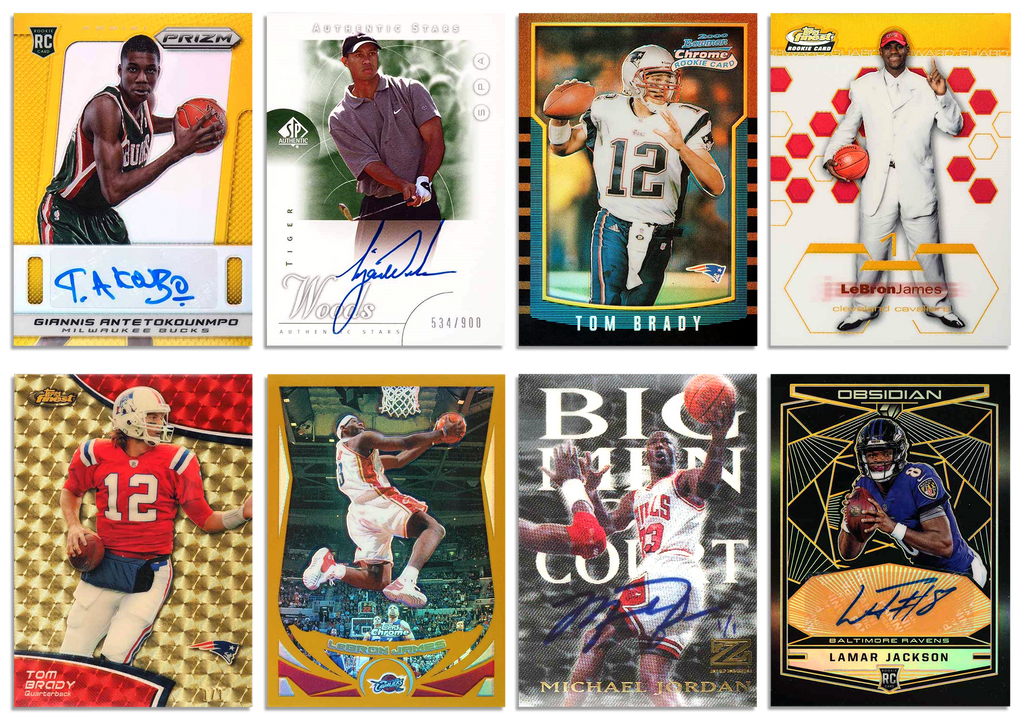
The 2000s and 2010s were transformative decades in the world of sports cards, marked by technological innovation, market expansion, and cultural shifts. These years saw several key developments that further evolved the hobby into a sophisticated and diverse market. Here are some notable advancements during these periods:
- Digital Revolution and Online Trading: The rise of the internet dramatically changed the sports card industry. Online marketplaces and trading platforms emerged, making it easier for collectors to buy, sell, and trade cards globally. This digital shift also facilitated the sharing of information about cards, values, and trends.
- High-Quality Printing and Advanced Design: Continuing the trend from previous decades, the 2000s and 2010s saw further advancements in printing technology. Cards were produced with even higher quality materials, intricate designs, and innovative features like holograms, reflective surfaces, and textured elements.
- Increased Use of Autographs and Memorabilia: Cards containing autographs of players or pieces of memorabilia (such as jersey swatches or bat fragments) became highly sought after. This trend added a tangible connection to the athletes and games, making these cards more unique and valuable.
- Diversification and Specialization of Card Types: Beyond standard player cards, the industry saw an increase in specialized cards. These included limited edition series, cards focusing on specific moments or milestones in sports, and cards targeted towards niche interests within the sports world.
- Rise of Grading Services and Authentication: As the market matured, the importance of card condition and authenticity grew. Professional grading services such as PSA and BGS (Beckett) became key players in the industry, providing standardized evaluations of card condition and thus influencing their market value.
- The Evolution of Rookie Cards: The concept of rookie cards continued to be a major focus, with collectors often speculating on the future success of young athletes. The potential investment value of these rookie cards often drove market trends.
- Integration of Technology and Interactivity: Some card manufacturers began integrating technology into cards, such as QR codes or NFC chips, offering collectors digital content or interactive experiences related to the card or athlete.
- Rise of Collector Communities and Social Media: Online forums, social media groups, and virtual trade shows expanded the collector community, making it more connected and dynamic. This also allowed for a greater exchange of knowledge and strategies among collectors.
- Investment and Speculation: The perception of sports cards as a potential investment grew significantly. Market speculation became more common, with some collectors focusing on the potential financial return of their collections rather than purely on the hobby aspect.
The 2000s and 2010s continued to shape the sports card industry through technological advancements, market expansion, and the integration of new media and global influences. These developments not only enhanced the collecting experience but also brought new dimensions to the value and significance of sports cards in popular culture. Upgrade how you store and transport your sports cards with our versatile sports card cases and backpacks.
Groundbreaking Era of Sports Cards in the 2020’s:
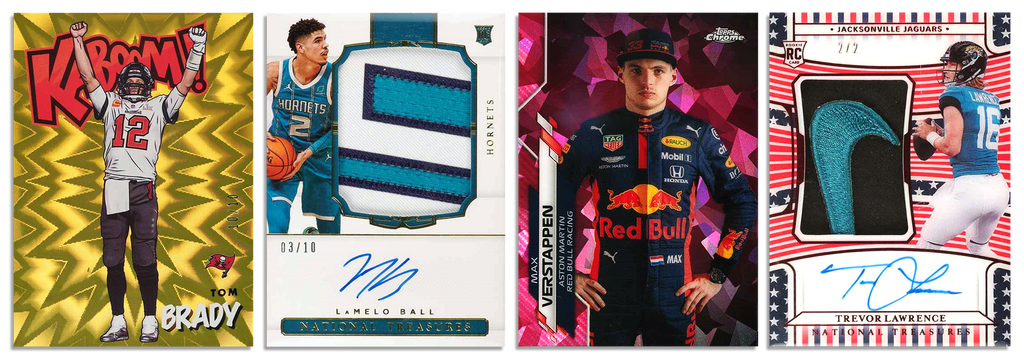
The 2020s have been a groundbreaking era for the sports card industry, marked by unprecedented changes and innovations. This decade is characterized by technological advancements, shifts in collector behavior, and the influence of global events. Here are some of the key developments in the sports card world during the 2020s:
- Impact of the COVID-19 Pandemic: The global pandemic had a significant impact on the sports card market. With more people staying at home, there was a surge in collecting as a hobby. This led to increased demand and prices for cards, especially for rare and vintage items.
- Rise of Digital and NFT-Based Cards: The 2020s saw the emergence of Non-Fungible Tokens (NFTs) and digital sports cards. These blockchain-based cards provide a new way of collecting, trading, and owning digital assets, revolutionizing the concept of sports card ownership and rarity.
- Advanced Analytics and Big Data: The use of analytics and big data in sports card collecting became more prevalent. Collectors and investors began utilizing data-driven approaches to assess the value of cards, predict market trends, and make informed purchasing decisions.
- Explosion of Online Marketplaces and Apps: The proliferation of online marketplaces and mobile applications dedicated to sports cards made the hobby more accessible. These platforms enabled easier buying, selling, and trading of cards, as well as community engagement and education.
- Globalization and Inclusion of Diverse Sports: There was an expansion in the diversity of sports represented in card collections. Alongside traditional North American sports, cards featuring international sports like soccer, cricket, and esports gained popularity, reflecting a more global perspective.
- Celebrity and Influencer Involvement: High-profile celebrities and influencers entered the sports card market, both as collectors and promoters. Their involvement brought new attention to the hobby and influenced market dynamics.
- Interactive and Augmented Reality Cards: Technological advancements led to the development of interactive and augmented reality (AR) sports cards. These cards offer immersive experiences, such as viewing player statistics or highlights by scanning the card with a smartphone.
- Increased Regulation and Authentication Services: As the market grew, so did concerns over counterfeits and fraud. This led to an increase in authentication services and regulatory measures to ensure the integrity and trustworthiness of the sports card market.
- Community and Social Responsibility Initiatives: The sports card industry saw a rise in community-focused and social responsibility initiatives. Companies and collectors engaged in charity auctions, donations, and programs to use the hobby for positive social impact.
The 2020s represent a transformative period for the sports card industry, driven by technological innovation, shifts in social and environmental consciousness, and the expanding global reach of sports. These developments have not only changed how collectors engage with their hobby but also broadened the cultural and economic significance of sports cards.
The Lasting Legacy of Sports Cards
As we conclude our exploration of the sports card industry, it's clear that these small pieces of cardboard have transcended their initial purpose to become timeless symbols of sports history and culture. From the tobacco cards of the 19th century to the digital and NFT-based cards of the 21st, sports cards have consistently mirrored the evolving trends in sports, technology, and society.
Their journey tells a story of innovation, passion, and nostalgia, capturing the essence of legendary athletes and unforgettable moments in sports. The sports card industry has not only survived various market fluctuations and technological shifts but has thrived, continually adapting and finding new ways to engage and fascinate collectors and fans alike.
The enduring appeal of sports cards lies in their ability to connect generations, serve as a medium for education and investment, and offer a tangible piece of sports history. As we look to the future, the sports card industry promises to continue its evolution, embracing new technologies and trends, while always reminding us of the simple joy of collecting and the timeless allure of sports heroes.
In essence, sports cards are more than just collectibles; they are a celebration of sports heritage, a testament to human creativity and innovation, and a cherished part of popular culture that will continue to captivate and inspire for generations to come.
Read about the evolution of sports cards, then find the ultimate sports card carrying case or sports card backpack to safeguard your collection. Shop now for premium protection!



Leave a comment